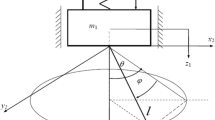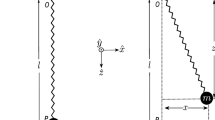Abstract
Using both analytical and numerical techniques, we investigate the 3-degree-of-freedom, autonomous, autoparametric, Hamiltonian spring–mass–pendulum system in libration and reveal the order–chaos–order transition with the change in the ratio of frequencies of corresponding independent normal modes. In the process, we also present an integrable limit of it and find all the three independent constants of motion. Furthermore, we study the possibility of the precession of the swing plane of the constituent spherical pendulum and the related energy exchanges between the modes at the autoparametric resonance. We use the method of the fast Lyapunov indicators to characterise and distinguish the order and the chaos in the system.








Similar content being viewed by others
References
Shinbrot, T., Grebogi, C., Wisdom, J., Yorke, J.A.: Chaos in a double pendulum. Am. J. Phys. 60(6), 491–499 (1992)
Tufillaro, N.B., Abbott, T.A., Griffiths, D.J.: Swinging Atwood’s machine. Am. J. Phys. 52(10), 895–903 (1984)
Tufillaro, N.: Integrable motion of a swinging Atwood’s machine. Am. J. Phys. 54(2), 142–143 (1986)
Elmandouh, A.A.: On the integrability of the motion of 3d-swinging Atwood machine and related problems. Phys. Lett. A 380(9–10), 989–991 (2016)
Leven, R.W., Koch, B.P.: Chaotic behaviour of a parametrically excited damped pendulum. Phys. Lett. A 86(2), 71–74 (1981)
van der Weele, J.P., de Kleine, E.: The order-chaos-order sequence in the spring pendulum. Phys. A Stat. Mech. Appl. 228(1–4), 245–272 (1996)
Anurag, B.M., Bhattacharjee, J., Chakraborty, S.: Understanding the order-chaos-order transition in the planar elastic pendulum. Phys. D Nonlinear Phenomena 402, 132256 (2020)
Anurag, B.M., Shah, T., Chakraborty, S.: Chaos and order in librating quantum planar elastic pendulum. Nonlinear Dyn. 103, 2841–2853 (2021)
Georgiou, I.T., Schwartz, I.B.: The slow invariant manifold of a conservative pendulum-oscillator system. Int. J. Bifurc. Chaos 06(04), 673–692 (1996)
Wang, F., Bajaj, A.K., Kamiya, K.: Nonlinear normal modes and their bifurcations for an inertially coupled nonlinear conservative system. Nonlinear Dyn. 42(3), 233–265 (2005)
Hatwal, H., Mallik, A.K., Ghosh, A.: Non-linear vibrations of a harmonically excited autoparametric system. J. Sound Vib. 81(2), 153–164 (1982)
El Rifai, K., Haller, G., Bajaj, A.K.: Global dynamics of an autoparametric spring-mass-pendulum system. Nonlinear Dyn. 49(1–2), 105–116 (2007)
Nayfeh, A.H., Mook, D.T.: Nonlinear Oscillation. Wiley, New York (1979)
Lynch, P.: Resonant motions of the three-dimensional elastic pendulum. Int. J. Non-Linear Mech. 37(2), 345–367 (2002)
Lynch, P.: Resonant Rossby wave triads and the swinging spring. Bull. Am. Meteorol. Soc. 84(5), 605–616 (2003)
Hatwal, H., Mallik, A.K., Ghosh, A.: Forced nonlinear oscillations of an autoparametric system—part 1: periodic responses (1983)
Hatwal, H., Mallik, A.K., Ghosh, A.: Forced nonlinear oscillations of an autoparametric system—part 2: chaotic responses (1983)
Bajaj, A.K., Chang, S.I., Johnson, J.M.: Amplitude modulated dynamics of a resonantly excited autoparametric two degree-of-freedom system. Nonlinear Dyn. 5(4), 433–457 (1994)
Banerjee, B., Bajaj, A.K., Davies, P.: Resonant dynamics of an autoparametric system: a study using higher-order averaging. Int. J. Non-Linear Mech. 31(1), 21–39 (1996)
Sheheitli, H., Rand, R.H.: Dynamics of a mass-spring-pendulum system with vastly different frequencies. Nonlinear Dyn. 70(1), 25–41 (2012)
Tabor, M.: Chaos and Integrability in Nonlinear Dynamics: An Introduction. Wiley-Interscience, London (1989)
Shojiguchi, A., Li, C.-B., Komatsuzaki, T., Toda, M.: Fractional behavior in multidimensional Hamiltonian systems describing reactions. Phys. Rev. E 76, 056205 (2007)
Bunimovich, L.A.: Relative volume of Kolmogorov–Arnold—Moser tori and uniform distribution, stickiness and nonstickiness in Hamiltonian systems. Nonlinearity 21(2), T13 (2008)
Lange, S., Bäcker, A., Ketzmerick, R.: What is the mechanism of power-law distributed Poincaré recurrences in higher-dimensional systems? EPL (Europhys. Lett.) 116(3), 30002 (2016)
Martens, C.C., Davis, M.J., Ezra, G.S.: Local frequency analysis of chaotic motion in multidimensional systems: Energy transport and bottlenecks in planar OCS. Chem. Phys. Lett. 142(6), 519–528 (1987)
Semparithi, A., Keshavamurthy, S.: Intramolecular vibrational energy redistribution as state space diffusion: classical-quantum correspondence. J. Chem. Phys. 125(14), 141101 (2006)
Juan Carlos Muzzio: Partially chaotic orbits in a perturbed cubic force model. Mon. Not. R. Astron. Soc. 471(4), 4099–4110 (2017)
Karmakar, S., Keshavamurthy, S.: Intramolecular vibrational energy redistribution and the quantum ergodicity transition: a phase space perspective. Phys. Chem. Chem. Phys. 22(20), 11139–11173 (2020)
Arnold, V.I.: Instability of dynamical systems with several degrees of freedom. Collected Works, vol. 1, pp. 423–427. Springer, Berlin (2009)
Benest, D., Froeschle, C., Lega, E.: Topics in Gravitational Dynamics: Solar, Extra-Solar and Galactic Systems, vol. 729. Springer, Berlin (2007)
Froeschlé, C., Guzzo, M., Lega, E.: Graphical evolution of the Arnold web: from order to chaos. Science 289(5487), 2108–2110 (2000)
Cordani, B.: Frequency modulation indicator, Arnold’s web and diffusion in the Stark–Quadratic–Zeeman problem. Phys. D 237(21), 2797–2815 (2008)
Barrio, R., Borczyk, W., Breiter, S.: Spurious structures in chaos indicators maps. Chaos Soliton Fract. 40(4), 1697–1714 (2009)
Maffione, N.P., Darriba, L.A., Cincotta, P.M., Giordano, C.M.: A comparison of different indicators of chaos based on the deviation vectors: application to symplectic mappings. Celest. Mech. Dyn. Astron. 111(3), 285 (2011)
Claude, F., Elena, L., Robert, G.: Fast Lyapunov indicators. Application to asteroidal motion. Celest. Mech. Dyn. Astron. 67(1), 41–62 (1997)
Karmakar, S., Keshavamurthy, S.: Relevance of the resonance junctions on the Arnold web to dynamical tunneling and eigenstate delocalization. J. Phys. Chem. A 122(43), 8636–8649 (2018)
José, J.V., Saletan, E.J.: Classical Dynamics: A Contemporary Approach. Cambridge University Press, Cambridge (1998)
Nayfeh, A.H.: Perturbation Methods. Wiley, London (2008)
Jeon, D.-O., Hwang, K.R., Jang, J.H., Jin, H., Jang, H.: Sixth-order resonance of high-intensity linear accelerators. Phys. Rev. Lett. 114(18), 184802 (2015)
Lichtenberg, A., Lieberman, M.: Regular and Chaotic Dynamics. Springer, New York (1992)
Dullin, H., Giacobbe, A., Cushman, R.: Monodromy in the resonant swing spring. Phys. D 190(1–2), 15–37 (2004)
Fitch, N.J., Weidner, C.A.: Parazzoli LP, Dullin HR, Lewandowski HJ: Experimental demonstration of classical Hamiltonian monodromy in the \(1\mathbin :1\mathbin :2\) resonant elastic pendulum. Phys. Rev. Lett. 103(3), 034301 (2009)
Cushman, R.H., Dullin, H.R., Giacobbe, A., Holm, D.D., Joyeux, M., Lynch, P., Sadovskií, D.A., Zhilinskií, B.I.: \(\rm C\rm O\rm _{2}\) molecule as a quantum realization of the \(1\mathbin :1\mathbin :2\) resonant swing-spring with monodromy. Phys. Rev. Lett. 93, 024302 (2004)
Giacobbe, A., Cushman, R.H., Sadovskií, D.A., Zhilinskií, B.I.: Monodromy of the quantum 1: 1: 2 resonant swing spring. J. Math. Phys. 45(12), 5076–5100 (2004)
Winnewisser, B.P., Winnewisser, M., Medvedev, I.R., Behnke, M., De Lucia, F.C., Ross, S.C., Koput, J.: Experimental confirmation of quantum monodromy: the millimeter wave spectrum of cyanogen isothiocyanate ncncs. Phys. Rev. Lett. 95(24), 243002 (2005)
Alexander, G.P., Vladimir, V.V.: Nonlinear oscillations of a spring pendulum at the 1: 1: 2 resonance: theory, experiment, and physical analogies. Proc. Steklov Inst. Math. 300(1), 159–167 (2018)
Swimm, R.T., Delos, J.B.: Semiclassical calculations of vibrational energy levels for nonseparable systems using the Birkhoff–Gustavson normal form. J. Chem. Phys. 71(4), 1706–1717 (1979)
Lowenstein, J.H.: Essentials of Hamiltonian Dynamics. Cambridge University Press, Cambridge (2012)
Bhattacharjee, J.K., Mallik, A.K., Chakraborty, S.: An introduction to nonlinear oscillators: a pedagogical review. Indian J. Phys. 81, 1115–1175 (2007)
Armitage, J.V., Eberlein, W.F.: Elliptic Functions, vol. 67. Cambridge University Press, Cambridge (2006)
Wolfram Research, Inc. Mathematica, Version 10
Lega, E., Froeschlé, C.: On the relationship between fast lyapunov indicator and periodic orbits for symplectic mappings. In: Dynamics of Natural and Artificial Celestial Bodies. Springer, Berlin, pp 129–147 (2001)
Acknowledgements
The authors thank Jayanta Kumar Bhattacharjee, Sourav Karmakar, and Srihari Keshavamurthy for helpful discussions.
Author information
Authors and Affiliations
Corresponding author
Ethics declarations
Conflict of interest
The authors declare that they have no conflict of interest.
Additional information
Publisher's Note
Springer Nature remains neutral with regard to jurisdictional claims in published maps and institutional affiliations.
Appendix: Comparison with the numerical solutions of exact system
Appendix: Comparison with the numerical solutions of exact system
To ascertain the robustness of the perturbative techniques and various other approximations made in Sect. 5, we must compare the unmodulated and modulated solutions with the numerical integration of the exact equations of motion of the SMSP. Comparing these two solutions, we see that the perturbative solutions of the unmodulated and modulated cases closely match the solutions of the exact system. To this end, we present Fig. 9 similar to Fig. 3, except for the fact that here we use exact equations of motion (Eqs. 2a–2c) instead of the approximated equations of motion (Eqs. 26a–26c). We use the same initial conditions as used in Fig. 3.
Precession of the swing plane about the z- axis is observed. Here, we compare the unmodulated and the modulated solutions with the numerical solutions of the exact system (Eqs. 2a–2c). The first column depicts the results for the unmodulated solutions (subplots (a)–(e)), while the second column shows the results for the modulated solution (subplots (f)–(g)). Subplot (a) and subplot (f) depict the precession about the z-axis in the unmodulated case and the modulated case, respectively. In subplots (b) and (g), we, respectively, plot \(\rho \equiv \sqrt{x^2+y^2}\) versus t for the unmodulated and the modulated solutions in dark red; the amplitudes A (black solid line) and B (black dashed line) closely follow the extrema of \(\rho \). Similarly, in subplots (e) and (j), we plot z versus t for both the cases in dark red. Here also, the amplitude C (green solid line) closely follows the extremum of z. Here, \(\alpha \) is fixed at 0.3
In Fig. 9a, we observe a precession of \(90^\circ \) in the x-y plane, on integrating up to \(t=836\) units, as observed in Fig. 3a. Additionally, it may be noted (as shown in Fig. 9b) that similar to Fig. 3b, here also, A and B closely follow, respectively, the maxima and the minima of \(\rho \equiv \sqrt{x^2+y^2}\),the radial distance from the z-axis. In Fig. 9c–e, we plot the time series for x, y and z of exact system. Also, C follows the extrema of z as can be seen in Fig. 9e.
In Fig. 9f, we observe a precession of the swing plane in the clockwise sense for the exact system. Additionally, in Fig. 9g, j, respectively, we see that analytically calculated (using Eqs. (33a)–(33f)) A and B closely follow the extrema of the numerically found \(\rho \) using the equations of motion of the exact system and the solution for C obtained from the modulated equations also closely follows the extrema of z for the exact system.
Rights and permissions
About this article
Cite this article
Anurag, Das, A. & Chakraborty, S. Order and chaos around resonant motion in librating spring–mass–spherical pendulum. Nonlinear Dyn 104, 3407–3424 (2021). https://doi.org/10.1007/s11071-021-06455-7
Received:
Accepted:
Published:
Issue Date:
DOI: https://doi.org/10.1007/s11071-021-06455-7





